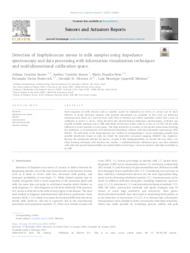Detection of Staphylococcus aureus in milk samples using impedance spectroscopy and data processing with information visualization techniques and multidimensional calibration space.
Detection of Staphylococcus aureus in milk samples using impedance spectroscopy and data processing with information visualization techniques and multidimensional calibration space.
Author(s): SOARES, J. C.; SOARES, A. C.; POPOLIN-NETO, M.; PAULOVICH, F. V.; OLIVEIRA JR, O. N.; MATTOSO, L. H. C.
Summary: Early diagnosis of cattle diseases such as mastitis caused by Staphylococcus aureus (S. aureus) can be made effective if on-site detection methods with portable instruments are available. In this work, we fabricated immunosensors based on a layer-by-layer (LbL) film of chitosan and carbon nanotubes coated with a layer of antibodies to detect S. aureus. Using electrical and electrochemical impedance spectroscopies, detection was possible in buffer solutions and in milk with limits of detection which could be as low as 2.6 CFU/mL for milk,sufficient to detect mastitis at early stages. This high sensitivity is ascribed to the specific interactions involving the antibodies, as demonstrated with polarization-modulated infrared reflection absorption spectroscopy (PMIRRAS). The selectivity of the immunosensor was verified by distinguishing S. aureus-containing samples from possible interferents found in milk, for which the interactive document mapping (IDMAP) was employed.Because the interferents affected the spectra, in spite of this distinguishability, we treated the data with a machine learning technique with decision tree models. A multidimensional calibration space was then obtained with rules that permit interpretability and predictability in detecting S. aureus in matrices with high variability as in milk.
Publication year: 2022
Types of publication: Journal article
Unit: Embrapa Instrumentation
Keywords: Immunosensor, Machine learning, Nanostructured film
Observation
Some of Embrapa's publications are published as ePub files. To read them, use or download one of the following free software options to your computer or mobile device. Android: Google Play Books; IOS: iBooks; Windows and Linux: Calibre.
Access other publications
Access the Agricultural Research Database (BDPA) to consult Embrapa's full library collection and records.
Visit Embrapa Bookstore to purchase books and other publications sold by Embrapa.

